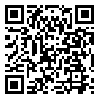Volume 72, Issue 2 (May 2014)
Tehran Univ Med J 2014, 72(2): 113-120 |
Back to browse issues page
Download citation:
BibTeX | RIS | EndNote | Medlars | ProCite | Reference Manager | RefWorks
Send citation to:



BibTeX | RIS | EndNote | Medlars | ProCite | Reference Manager | RefWorks
Send citation to:
Javadinia S, Asgarian R, Noorbaksh S, Soboti B, Shokrollahi M R, Tabatabaee A. Toxic shock syndrome toxin level in wound samples of hospitalized children with burn: a case control study . Tehran Univ Med J 2014; 72 (2) :113-120
URL: http://tumj.tums.ac.ir/article-1-5941-en.html
URL: http://tumj.tums.ac.ir/article-1-5941-en.html
Shima Javadinia1 
 , Ramin Asgarian2
, Ramin Asgarian2 
 , Samileh Noorbaksh2
, Samileh Noorbaksh2 
 , Behnam Soboti3
, Behnam Soboti3 
 , Mohammad Reza Shokrollahi4
, Mohammad Reza Shokrollahi4 
 , Azardokht Tabatabaee *
, Azardokht Tabatabaee * 
 5
5

 , Ramin Asgarian2
, Ramin Asgarian2 
 , Samileh Noorbaksh2
, Samileh Noorbaksh2 
 , Behnam Soboti3
, Behnam Soboti3 
 , Mohammad Reza Shokrollahi4
, Mohammad Reza Shokrollahi4 
 , Azardokht Tabatabaee *
, Azardokht Tabatabaee * 
 5
5
1- Department of Internal Medicine, Research Center of Pediatric Infectious Diseases, Iran University of Medical Sciences, Tehran, Iran.
2- Department of Pediatric Infectious Disease, Research Center of Pediatric Infectious Diseases, Iran University of Medical Sciences, Tehran, Iran.
3- Shahid Motahari Burn Hospital, Iran University of Medical Sciences, Tehran, Iran.
4- Department of Pediatric Infectious Disease, Hazrat-e- Masoumeh Hospital, Ghom University of Medical Sciences, Ghom, Iran.
5- Department of Pediatric Infectious Disease, Research Center of Pediatric Infectious Diseases, Iran University of Medical Sciences, Tehran, Iran. ,cpidir@gmail.com
2- Department of Pediatric Infectious Disease, Research Center of Pediatric Infectious Diseases, Iran University of Medical Sciences, Tehran, Iran.
3- Shahid Motahari Burn Hospital, Iran University of Medical Sciences, Tehran, Iran.
4- Department of Pediatric Infectious Disease, Hazrat-e- Masoumeh Hospital, Ghom University of Medical Sciences, Ghom, Iran.
5- Department of Pediatric Infectious Disease, Research Center of Pediatric Infectious Diseases, Iran University of Medical Sciences, Tehran, Iran. ,
Abstract: (7249 Views)
Background: Toxic shock syndrome (TSS), a dangerous consequence of Toxic shock syndrome toxin-1 (TSST-1) caused by Staphylococcus aureus. The early detection for infections of Staphylococcus aureus in burned children is very important, also the pre-vention for consequences of TSST-1. Fever is one of the most noticeable sign in burned children. On the other hand, fever is one of the important consequences of TSST-1 pro-duction.
Methods: This study aimed to assess the toxic shock syndrome toxin-1 level in the wound’s specimens of two groups febrile and afebrile in the hospitalized burned chil-dren in Motahari hospital Tehran, Iran in the year 2013. In this case-control study, 90 children who admitted to the burn unit, divided in two groups of 45 patients: febrile (cases group) and afebrile (control group). All of burned children under went wound biopsy, and then all of wound’s specimens were tested by PCR for specific primer of toxin producing genome. Finally all of data collected and statistically analyzed. This data include group febrile and afebrile, demographic characteristics, percentage of burned surface severity and result of PCR.
Results: The positive result for PCR test, production of TSST-1 in febrile burned chil-dren (cases group) was 37.7% and in afebrile burned children (control group) was 11.1% that this different was statistically significant (P=0.003). The mean and stan-dard deviation for percentage of burned surface (severity) in samples with positive re-sult for PCR test was 30.9±16.93 and in samples with negative result for PCR test was 20.09±11.02 that this different was statistically significant (P=0.01). There was no dif-ference between positive PCR result and negative PCR result of age and sex.
Conclusion: Direct association was approved between the production of TSST-1 and the occurrence of fever in burned children. Increased surface severity of burns also re-lated to the production of TSST-1. Further research is recommended.
Keywords: burns, fever, polymerase chain reaction, staphylococcus aureus, toxic shock syndrome toxin-1
Type of Study: Original Article |
Send email to the article author
| Rights and permissions | |
 |
This work is licensed under a Creative Commons Attribution-NonCommercial 4.0 International License. |



